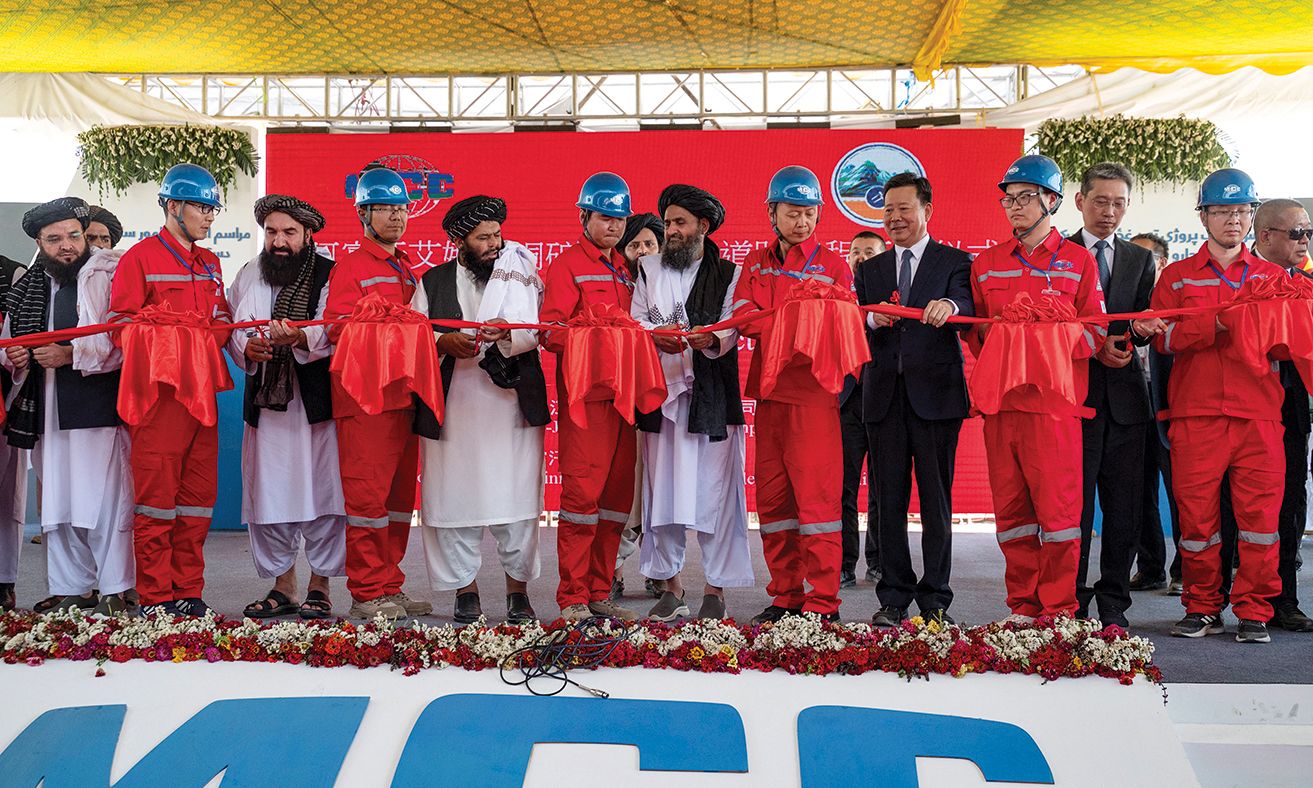In July the mining project at Mes Aynak was inaugurated by Afghan and Chinese officials Wakil Kohsar/AFP via Getty Images
Fears circulated over the summer that open-pit mining at the Afghan archaeological site of Mes Aynak was about to begin—bringing with it the destruction of the astonishingly preserved site. However, the July ceremony presided over by Hedayatullah Badri, the acting minister of mines and petroleum for the Taliban government, unveiled a far better case scenario: the start of underground mining, which—if all goes to plan—will allow for the survival of the 1,700-year-old Buddhist city.
“Our long-term strategy on Mes Aynak foresees the full protection of the site,” Mawlawi Atiqullah Azizi, the Afghan deputy minister of culture and information, tells The Art Newspaper. “The mining will be carried out with underground technique[s], which … will be kept up to the end of the mining process. No damage shall be posed to relics during the mining extraction.” Mes Aynak sits above a reported 6m-12m tonnes of copper.
The 400,000 sq. m site at Mes Aynak is home to artefacts dating back to the Bronze Age Didier Tais
In December last year, the Afghan government and China Metallurgical Group Corporation (MCC) reached the underground mining deal—a significantly more expensive method of copper extraction that will protect the site’s stupas, murals, statuary and other structures. The 30-year deal requires MCC to provide public services, such as the construction of clinics and mosques, and to ensure local job opportunities. Mining is expected to begin as early as next spring.
It is a stunning reversal of fortune. “We started with high hopes, but we didn’t hold our breath that such an outcome was even possible,” says Ajmal Maiwandi, the chief executive officer of the Aga Khan Trust for Culture (AKTC), the major heritage protection agency in Afghanistan. “Now—at the very least—we can be certain that Mes Aynak won’t be completely erased.”
The area of around 400,000 sq. m has artefacts dating as far back as the Bronze Age. In the fifth to seventh centuries, it flourished as a key stop on the Silk Road. Buddhist monks and others learned how to extract the copper that it sits above, using their wealth to create richly carved monasteries and stupas, as well as extensive surrounding infrastructure, such as smelting workshops and housing.
The copper ore that was the source of its prosperity has also been its thorn. In 2007 MCC won rights to the ore for 30 years for $3bn, and the site was expected to be razed as open-pit mining began. But due to the lack of security over the past two decades, no extraction went ahead. When the Taliban returned to power three years ago, talks resumed with MCC, who reportedly tried to renegotiate the terms of the contract. Many believed it improbable that the Afghan government would forgo the $250m-$300m per year that the mine was expected to bring in—even though the Afghan government was vocal about protecting the site.
In 2022, AKTC, which is overseeing the preservation of Mes Aynak, received a $1.2m grant from the Swiss-based Aliph Foundation for salvage archaeology, documenting and protecting what exists and preparing to remove statuary and carvings to the National Museum of Afghanistan. However, the government appears to have maintained its support for the site, and has been surprisingly supportive of heritage preservation overall, as The Art Newspaper recently reported. “We are moving forward to remove and disqualify encroachments, return confiscated heritage lands, identify vulnerable sites, conduct surveys, prevent smuggling of artefacts and taking necessary measures to protect, maintenance and safeguard heritage,” Azizi says.
Protection of sites such as Mes Aynak further suggests that the Taliban has moved away from its disavowal of Afghanistan’s non-Islamic past, which was behind the 2001 explosion of the Bamiyan Buddhas. Its strict interpretation of Islam, however, continues to inform its social agenda, including restrictions on cultural forms such as music and, more broadly, women’s rights.
The ultimate plan for Mes Aynak—as for all of Afghanistan’s rich heritage sites—is tourism, though this will be a long way off. Many observers also query how effectively the government can preserve the country’s cultural heritage. As yet, there is no comprehensive framework in place, and even Azizi concedes that the country is reliant on external funding for heritage protection.
On MCC’s side, the agreement reflects China’s increasing commitment to heritage protection. (MCC declined to supply a spokesperson for interview.) In 2021 the country launched the Alliance for Cultural Heritage in Asia, a multilateral association among Asian nations, and last year released the Xi’an Declaration, a statement underlining China’s commitment to international sites. The country has also recently carried out several joint archaeological projects along the Silk Road and elsewhere in Asia, including in the Middle East.
China’s willingness to take the financial loss that underground mining entails also reflects market realities around copper ore. The country currently faces a surfeit of the mineral, despite its increasing importance to global industry. In the long term, copper prices are expected to rise, meaning that even a slower extraction will still pay off. And the agreement strengthens the political relationship between the two countries.
However, key questions remain in terms of just how intrusive the underground method will be; the size of the above-ground operation; and, most importantly, whether the delicate structures will withstand the heavy vibrations. The agreement is great news—but much remains to be done to preserve the city.

